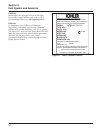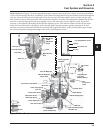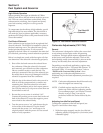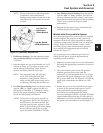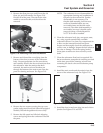
5.8
Section 5
Fuel System and Governor
High Altitude Operation
When operating the engine at altitudes of 1500 m
(5000 ft.) and above, the fuel mixture tends to get over-
rich. This can cause conditions such as black, sooty
exhaust smoke, misfiring, loss of speed and power,
poor fuel economy, and poor or slow governor
response.
To compensate for the effects of high altitude, special
high altitude jet kits are available. The kits include a
new main jet, slow jet (where applicable), necessary
gaskets and O-Rings. Refer to the parts manual for the
correct kit number.
Fuel Shut-off Solenoid
Some carburetors are equipped with an optional fuel
shut-off solenoid. The solenoid is installed in place of
the bowl retaining screw. The solenoid has a spring-
loaded pin that retracts when 12 volt current is
applied to the lead. When it is extended, the main fuel
jet is blocked, preventing normal carburetor operation.
Below is a simple test, made with the engine off, that
can determine if the solenoid is functioning properly:
1. Shut off the fuel and remove the solenoid from
the carburetor. When the solenoid is loosened
and removed, gas will leak out of the carburetor.
Have a container ready to catch the fuel. The
main jet is mounted in the tip of the solenoid pin.
Be careful that it does not get damaged while the
solenoid is separated from the carburetor.
2. Wipe the tip of the solenoid with a shop towel or
blow it off with compressed air, to remove any
remaining fuel. Take the solenoid to a location
with good ventilation and no fuel vapors present.
You will also need a 12 volt power source that can
be switched on and off.
3. Be sure the power source is switched “off”.
Connect the positive power source lead to the red
lead of the solenoid. Connect the negative power
source lead to the solenoid body.
4. Turn the power source “on” and observe the pin
in the center of the solenoid. The pin should
retract with the power “on” and return to its
original position with the power off. Test several
times to verify operation.
Figure 5-5. Fuel Shut-off Solenoid Location.
Carburetor Adjustments (CV17-740)
General
The carburetor is designed to deliver the correct fuel-
to-air mixture to the engine under all operating
conditions. The high speed mixture adjustment is set
at the factory and cannot be adjusted. The low idle
fuel adjusting needle (some models) is also set at the
factory and normally does not need adjustment.
Depending on model and application, engines may
also be equipped with a “Governed Idle System.” If
equipped with a “Governed Idle System”, refer to
“Models with Governed Idle System” when
performing any carburetor adjustment, as an
additional step to the listed adjustment procedure(s) is
required.
NOTE: Carburetor adjustments should be made only
after the engine has warmed up.
NOTE: Certified engines may have a fixed idle or
limiter cap on the idle fuel adjusting needle.
Do not attempt steps 1 and 2 below. Proceed
directly to step 3. Step 5 can only be
performed within the limits allowed by the
cap.
Adjusting Low Idle Fuel and Speed
To adjust the carburetor idle fuel and speed, see
Figure 5-6 and follow these steps.
1. With the engine stopped, turn the low idle fuel
adjusting needle (if equipped) in (clockwise) until
it bottoms lightly.
Fuel Shut-Off
Solenoid





